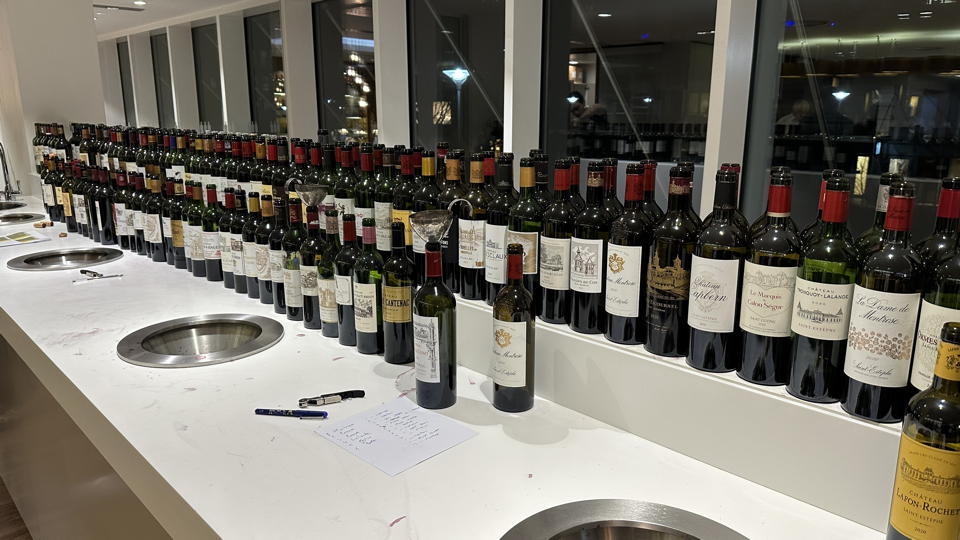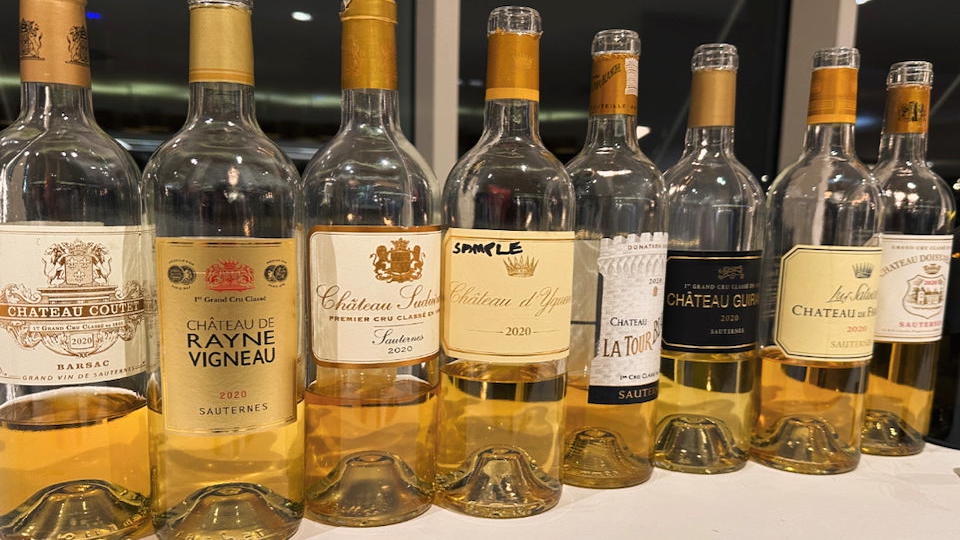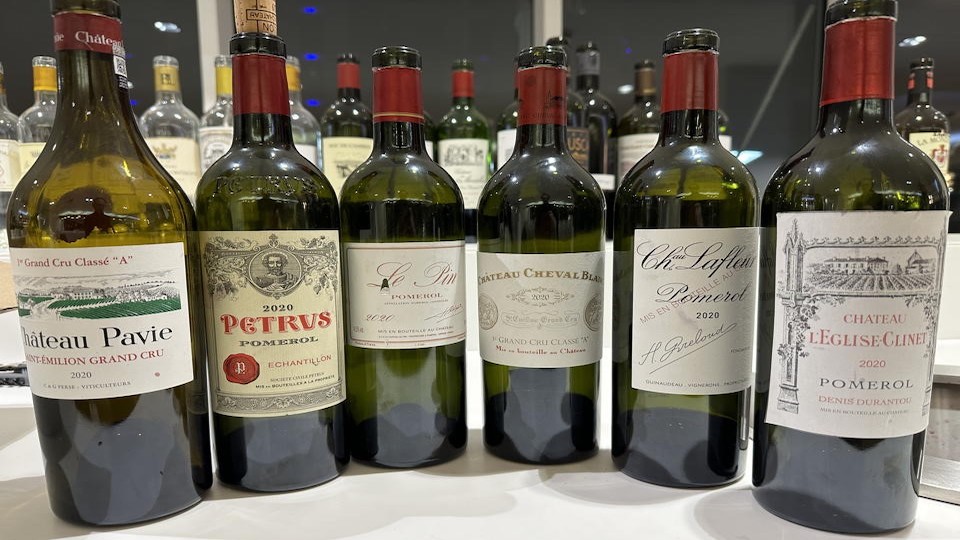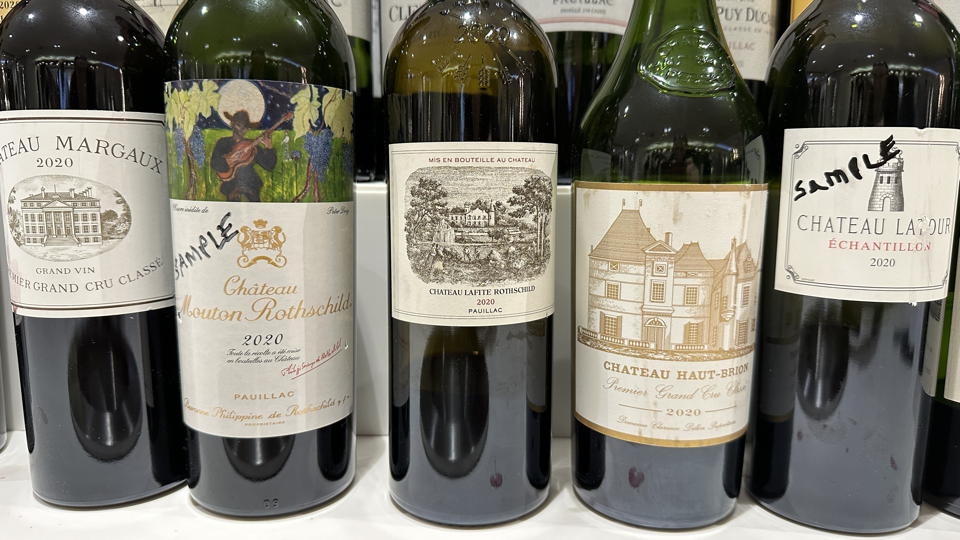Browse using the new Vinous website now. Launch →
Printed by, and for the sole use of . All rights reserved © 2015 Vinous Media
Bordeaux 2020 – The Southwold Tasting
BY NEAL MARTIN | November 12, 2024
January 2020. A New Year message pops into my mailbox noting the significance.
“Vingt-vingt.”
“Vin Vin!” Surely, an omen that it would be a great year?
Two months later, the entire world was pulling down its shutters as the pandemic commenced its world tour. A virus completely dismantled normal life. All we could do was go jogging on empty roads and buy en primeur. The 2020 growing season rests in a surreal haze of upturned history, so I was naturally intrigued to see how the wines would show when it was 2020’s turn for the annual Southwold tasting in January, having already tasted them just after bottling. As usual, we convened in London for three days, with sessions devoted to the dry whites, reds and Sauternes. We tasted the wines single-blind in peer groups, mostly within appellations, with all bottles coming from châteaux except for one.
The Growing Season
The world might have been upturned, but the weather will always continue.
The 2020 growing season began with an unseasonably warm winter that saw the highest temperatures in a century and one-third of the average frost. After the previous dry summer, vineyard managers welcomed the high rainfall—twice the average during November, December and March—with some châteaux reporting a year’s precipitation in six months. Between these events, a series of storm-laden low-pressure systems swept across the region during January and February. Most of a somewhat uneven bud break took place in the middle of March, and the end of that month saw a dive in temperatures down to -12°C in some locales, with snow on March 30. Thankfully, frost damage was limited to prone spots. April was warm and rainy, conditions that encouraged rapid shoot growth. May was the fourth hottest in 75 years. It was like summer in terms of temperature due to hot spells at the beginning and the end of the month, with 16 days above 25°C. Humidity and warmth provided perfect conditions for mildew, necessitating that vineyard managers be vigilant and seize every dry window to spray and protect their vines. Below-average temperatures from May 10 to May 15 coincided with another rainy spell. Flowering came early in mid-to-late May with little coulure. By that point, winemakers knew they were heading toward an early harvest.
June began cool and overcast, delaying vine growth, while persistent rain increased mildew pressure. Some estates suffered considerable losses with some millerandage. In the final week of June, the weather changed again, beginning nearly two months of warm and extremely dry conditions. Several estates reported not a single drop of rain during the 54-day dry period. Hydric stress was initially stymied by the preceding months of rain, with only minor stress noticed on young vines on free-draining gravel and sandy soils. Clayey soils in Saint-Estèphe and the Right Bank advantaged those châteaux in their superior moisture-retaining capacity. Uneven véraison slowed down maturity in the most stressed plots. By the second week of August, winemakers grew concerned as vines began to suffer during a heat wave. Nighttime temperatures during that period remained above 20°C, giving the vines no time to rest. This heat triggered convectional storms between August 9 and 14, alleviating the hydric stress. However, rainfall varied, highest in the northern Médoc and lowest on the Right Bank, exaggerating unevenness between appellations and terroirs depending on grape variety and vine age.
Storm clouds dispersed, and clement, warm and dry conditions prevailed through to harvest, concentrating the berries and sugar levels. Temperatures were slightly cooler than average, and the chilly nights between 12-14°C enabled berries to retain acidity that ultimately imparted freshness to the wines. The first two weeks in September were warm and sunny, accelerating sugar accumulation.
Picking of the dry whites began on August 14 with the earliest-ripening Sauvignon Blanc, although the heart of the vendange was over the final ten days in August, seemingly now the norm. The Merlot came in starting around September 10 under warm and dry conditions, predicating a propitious vintage in Merlot-dominated blends, especially on the Right Bank. Some estates harvested in the mornings because of the heat, keeping both fruit and workers fresh, with some châteaux investing in increasingly useful cool rooms. Often, there is a pause between the Merlot harvest and the later-ripening Cabernets, but several estates continued straight on as the Cabernets were phenolically ripe. This proved crucial. The weather turned inclement around mid-September, with sporadic light rain showers. This is where the true quality of the 2020 growing season becomes a little opaque—many winemakers euphemistically brushed off the effect of this rainfall as inconsequential. Too light to dilute the grapes, if anything, it merely warded off shriveling and nudged them toward full ripeness. But conditions worsened—collateral damage courtesy of Storm Alex—which prompted some winemakers to panic, with the more risk-averse expediting the picking of Cabernet Sauvignon. Most harvests were done and dusted either by the end of September or early October.
The Wines
As I have written previously, when tasting wines blind within their peer groups, one is almost always a touch more critical. Juxtaposition ruthlessly exposes any shortcomings. Moreover, despite all efforts to prepare these young wines (double-decanting each one and ensuring optimal temperatures), the fact is that some wines are not predisposed to show their best. Some just shut down, acting stubbornly as if deliberately trying to deceive the taster—it is part of their growing-up phase. Though winemakers are almost obsessive about making their clarets approachable, a leopard cannot just change its spots. Whilst tannins have unquestionably become more malleable in their youth, the DNA of Bordeaux châteaux is as unchanged as the terroir. Perhaps that’s no bad thing. The greatest Bordeaux should be long-distance runners, not sprinters that soon run out of breath.
As a consequence, some of my scores are a little lower than when I encountered these wines at the end of 2022. That’s normal. However, there is plenty to savor. I was still impressed, and it did not dent my admiration. I would still rank 2020 ahead of 2018 and slightly behind both 2019 and 2022. Perhaps 2020 doesn’t quite possess the vaulting ambition of those two vintages, though in some cases, it surpasses the best of both.
The dry whites were a little hit-and-miss. I was expecting more from Les Champs Libres, which seems intent on following its sibling Lafleur in sulking during blind tastings. It is a little reductive on this day, though the Grand-Village Blanc compensated and represents a great value. There are some standouts amongst this category, not the least of which are an impressive Malartic-Lagravière Blanc, Domaine de Chevalier Blanc and Smith Haut-Lafitte Blanc (the usual suspects), plus a pleasant surprise courtesy of Couhins-Lurton. I couldn’t get my head around the Haut-Brion Blanc, which might not have been the best bottle, nor did the La Mission Haut-Brion Blanc shine. Given the price of those, I might spend my pennies on the excellent La Louvière Blanc. Our lineup also included a range of dry Sauternes. I feel these are still finding their place inasmuch as I rarely find myself yearning for a dry white Sauternes. It is a step in the right direction, though one forced upon winemakers because their sweet wines continue to be difficult to sell.
In 2020, the sweet Sauternes reflect a very good rather than excellent vintage. Highlights include de Fargues, Rieussec, Doisy-Daëne and Coutet, though none exhausted my supply of superlatives. Yquem is superb, although I could not winnow it out from its peers. Overall, they miss the acidic spine that lends them that all-important nerve to counterbalance the residual sugar. The best 2020s are redeemed by wonderful purity and seductiveness, plus they will be more approachable than other vintages.
Now for the reds. Let’s commence on the Right Bank with the largest flotilla of wines: Saint-Émilion. This is a much-improved appellation that is now host to an array of styles instead of a “monoculture” of opulent wines that seemed to come from the same template.
Did you buy the 2020 Canon when released en primeur? You did? Good. Because it’s ruddy marvelous, a benchmark for this historic estate and perhaps their greatest release under winemaker Nicolas Audebert and his team. It’s not quite perfection in my book…but it’s in the same postcode. If you’ve got more to shell out, the usual suspects all deliver. Ausone and Cheval Blanc are at the top of the pile, with Figeac, Angélus, Bélair-Monange, Valandraud and a reformatted, more refined Pavie close on that pair’s heels. There are plenty of others that merit a mention: TrotteVieille, which meliorated wonderfully in the glass, Tour Saint-Christophe and a brilliant La Clotte from the Vauthier family. I was also taken by Côte de Baleau, Grand Mayne, Berliquet, Le Dragon de Quintus (the surprise package, given that it’s a second label), Poesia and Les Grandes Murailles. A few wines in this cohort felt a little smudged by the warmth of the summer, but otherwise, this was a pleasing showing.
The Pomerol flight was a bit patchier than I have become accustomed to. Again, a selection of wines from less propitious terroirs succumbed to the warmth more than those on the gravel plateau, with VA affecting some of the bottles. But there are indeed outstanding successes: La Fleur-Petrus, Trotanoy and L’Eglise-Clinet are utterly delicious, with plenty in the gas tank to ensure long-term cellaring. The Lafleur will turn into a great wine, but it is often sultry and introspective at this early stage, which swayed my score away from where it will ultimately rest. I adored the regal Petrus, though in this vintage, it doesn’t quite put a large gap between itself and its peers. That takes nothing away from its finely chiseled tannins and tension. Perhaps overall, the 2019s in Pomerol have an edge over the 2020s.
Moving to Pessac-Léognan, the wines are, again, a little hit-and-miss. I am not sure what’s going on at Haut-Bergey, but I cannot fathom how it could feel underripe in a vintage like 2020. Biodynamic practices are fine, but rule one: the fruit must be ripe. Conversely, the Château de Fieuzal was a little overripe, and the bottle from Malartic-Lagravière was such an odd showing vis-à-vis previous bottles that I decided not to score it. Thankfully, the Haut-Brion showed its class, though on this occasion, I lean slightly toward La Mission Haut-Brion thanks to its bravura finish—two stunning wines crafted by Jean-Philippe Delmas and his team. Pape Clément shows more and more elegance each year, though it still requires time. The Domaine de Chevalier was all old school class on this occasion, whilst Les Carmes Haut-Brion was floral and fabulous, if not quite the best vintage that Guillaume Pouthier has fashioned.
The appellation of Margaux is what you might call “solid.” Certainly, in recent years, it has gained consistency by way of those with less auspicious terroirs upping their game. The real superstar is, predictably, the First Growth. It ranks amongst the best Left Bank wines of the vintage and is a stupendous success for Philippe Bascaules and his team. In this tasting, it shaded the 2020 Palmer, though I found the Palmer very mercurial and difficult to pin down in the glass. Brane-Cantenac and Rauzan Ségla performed extremely well, as did the second label, Ségla. Giscours, Malescot Saint-Exupery and Marquis de Terme were excellent, whilst Prieuré-Lichine, Siran and Dauzac would probably be kinder to your wallet.
Saint-Julien raised the bar with a cluster of outstanding wines. This was perhaps the flight that solidified 2020 as a bona fide great vintage on the Left Bank. Léoville Poyferré is the one that really excels—just a fabulous wine. The 2020 Léoville Las-Cases is primal and nascent. A long-term prospect, it’s more expensive than the Poyferré, though it’s First Growth in all but name in this vintage. Hot on its heels, a stunning Léoville and Langoa Barton, with Damien Barton crafting more finessed and complex wines these days. Gloria, Beychevelle, Lagrange, Gruaud Larose (rejuvenated under winemaker Virginie Sallette) and Talbot all showed wonderfully. Perhaps Branaire-Ducru is a little better in vintages like 2022? This tasting was a reminder, if one was needed, that Saint-Julien can really turn on the style in a benevolent vintage, arguably representing better value than the appellation just north…
Hail! Hail! Pichon Longueville Comtesse de Lalande! Nicolas Glumineau crafted a scintillating, effortless, composed and delicious wine that, as I write in my tasting note, flirts with perfection. Don’t get me wrong, the First Growths are outstanding, although mea culpa, I’m human and completely misread Lafite-Rothschild, partly because it seemed to have closed up at this juncture. The Borie family oversaw a superb Grand-Puy-Lacoste, a brilliant Pauillac that conveys unerring symmetry and poise. The Pichon Baron is delineated and maybe a little conservative, yet with real panache on the finish.
We finish in Saint-Estèphe. Montrose is the standout of the appellation. It is not the very finest bottle I have encountered, and indeed, it obliges two or three hours of aeration to show its best. But it is an Everest of a wine, certainly one to tuck away in a cellar and forget about for at least a decade, maybe two. The real surprise—though not if you’re Managing Director Véronique Dausse—is the 2020 Phélan Ségur, surely one of the best values given its reasonable price, likewise, Montrose’s stablemate, Tronquoy-Lalande. Cos d’Estournel came across a little more understated aromatically than expected, though it exhibits a persistent finish, whilst Lafon-Rochet (made when Basile Tesseron still ran the estate) is another that surpassed expectations.
Final Thoughts
In my original primeur report, composed in the middle of lockdown, I wrote: “Twenty-twenty was born in a tumultuous world. Let’s pray that these wines will be enjoyed when we can return to sharing them together.”
Thankfully, prayers were answered. Revisiting this vintage, I aver that warmer summers and higher alcohol with more richness tend to foment a little more instability and inter-bottle variation. There are more incidences of VA compared to cooler vintages. That is logical because, despite technological advances, higher-alcohol wines seem prone to greater variation. But the vintage does bestow Bordeaux-lovers with a bevy of outstanding wines that should stand the test of time. It is less crammed with legends in the making, like 2019 or, I suspect, 2022. The problem that Bordeaux cannot quite square is that its unique selling proposition is to produce top-level wines in large volume, recently in almost every vintage. Bravo! However, when prices increase, the pool of consumers willing to pay those prices diminishes. There’s no rarity factor like there is in Burgundy.
This undermines the raison d’être of buying primeur. So, the top wines in this report not only compete against each other, but also with themselves in terms of alternative available vintages. The day I wrote this paragraph, the Financial Times quoted a Liv-Ex report that claims: “Only four of the top estates have delivered positive en primeur returns post-release in 2017-2021”. Not good PR. That puts a vintage like 2020 in a tricky position. Checking some of the prices of the 2020s in this report, some have fallen since I tasted the wines in January.
So why buy then? That’s entirely up to consumers. Maybe, if economic conditions change, consumers will flood back and pick up vintages like 2020? Market prices will always find their equilibrium, and if that necessitates heavy discounting or even dumping overpriced stock to free up cash, nobody can stop that.
But my job is to report on the quality, and for sure, the 2020 Bordeaux reds are going to give a great deal of pleasure.
The only question is, if not now, then when?
You Might Also Enjoy
Bordeaux 2020: Saving the Best for Last, Antonio Galloni, February 2023
Thrice Is Nice: Bordeaux 2020 in Bottle, Neal Martin, February 2023
2020 Bordeaux En Primeur: Almost Back to Normal, Antonio Galloni, June 2021
Vingt-Vingt Vins: Bordeaux 2020, Neal Martin, May 2021
Show all the wines (sorted by score)
- Alcée
- Angélus
- Ausone
- Bastor-Lamontagne
- Batailley
- Beaumont
- Beauregard
- Beauséjour Bécot
- Bélair-Monange
- Belgrave
- Bellefont Belcier
- Berliquet
- Beychevelle
- Bouscaut
- Branaire-Ducru
- Branas Grand Poujeaux
- Brane-Cantenac
- Calon Ségur
- Canon
- Canon-la- Gaffelière
- Cantemerle
- Cantenac Brown
- Capbern
- Carbonnieux
- Certan de May
- Chasse-Spleen
- Château Beauséjour JDL
- Château Margaux
- Cheval Blanc
- Clerc Milon
- Climens
- Clinet
- Clos de l'Oratoire
- Clos des Jacobins
- Clos Fourtet
- Clos Haut-Peyraguey
- Clos l'Église
- Clos Saint-Martin
- Clos Vieux Taillefer
- Cos d'Estournel
- Cos Labory
- Côte de Baleau
- Couhins-Lurton
- Coutet
- Couvent des Jacobins
- d'Aiguilhe
- d'Arche
- d'Armailhac
- Dauzac
- de Camensac
- de Fargues
- de Fieuzal
- de Fonbel
- de Myrat
- de Sales
- d'Issan
- Doisy-Daëne
- Doisy-Védrines
- Domaine de Chevalier
- Duhart-Milon
- du Tertre
- Enclos Tourmaline
- Figeac
- Filhot
- Fombrauge
- Fonplégade
- Gazin
- Giscours
- Gloria
- Gracia
- Grand Mayne
- Grand-Puy Ducasse
- Grand-Puy-Lacoste
- Grand Village
- Gruaud Larose
- Guinaudeau Vignerons
- Guiraud
- Haut-Bailly
- Haut-Batailley
- Haut-Bergey
- Haut-Brion
- Haut-Marbuzet
- JCP Maltus - Vieux Château Mazerat
- Joanin Bécot
- Kirwan
- La Chenade
- La Clotte
- La Conseillante
- La Croix de Gay
- La Dominique
- Lafite-Rothschild
- Lafleur
- La Fleur de Gay
- La Fleur-Pétrus
- Lafon-Rochet
- La Gaffelière
- La Garde
- Lagrange (Saint-Julien)
- La Lagune
- La Louvière
- La Mission Haut-Brion
- La Mondotte
- Lamothe-Guignard
- Lanessan
- Langoa-Barton
- Larcis Ducasse
- Laroque
- Laroze
- Lascombes
- Latour
- La Tour Blanche
- La Tour Carnet
- La Tour Figeac
- La Tour-Martillac
- La Violette
- Le Boscq
- Le Crock
- Le Dôme
- Le Gay
- L'Eglise-Clinet
- L'Enclos
- Léoville Barton
- Léoville Las Cases
- Léoville Poyferré
- Le Pin
- Les Carmes Haut-Brion
- Les Charmes-Godard
- Les Cruzelles
- Les Grandes Murailles
- Les Perrières
- L'Évangile
- L'Hêtre
- L'If
- Lynch-Bages
- Magrez-Fombrauge
- Malartic-Lagravière
- Malescot Saint-Exupéry
- Marquis d'Alesme Becker
- Marquis de Terme
- Mauvesin Barton
- Meyney
- Monbousquet
- Monbrison
- Montlandrie
- Montrose
- Montviel
- Moulin Riche
- Moulin Saint-Georges
- Mouton-Rothschild
- Olivier
- Ormes de Pez
- Palmer
- Pape Clément
- Pape-Clément
- Paveil de Luze
- Pavie
- Pavie Macquin
- Pédesclaux
- Petit Village
- Petrus
- Phélan Ségur
- Pichon Baron
- Pichon-Longueville Comtesse de Lalande
- Poesia
- Pontet-Canet
- Poujeaux
- Prieuré-Lichine
- Quinault L'Enclos
- Quintus
- Rabaud-Promis
- Rauzan-Ségla
- Raymond-Lafon
- Rayne-Vigneau
- Rieussec
- Roc de Cambes
- Rol Valentin
- Rouget
- Saint-Pierre (Saint-Julien)
- Sigalas Rabaud
- Siran
- Smith Haut Lafitte
- Smith Haut-Lafitte
- Sociando-Mallet
- Talbot
- Tertre-Rôteboeuf
- Tour Saint Christophe
- Tronquoy-Lalande
- Troplong Mondot
- Trotanoy
- TrotteVieille
- Valandraud
- Vieux Château Certan
- Yquem




